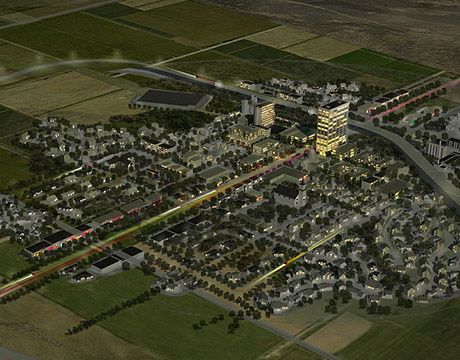An Urban Platform for Big Thinkers, Big Systems
An Urban Platform for Big Thinkers, Big Systems


City Lab, an unpopulated, fully operating, and real-world lab environment representative of a mid-sized American city. Image: CITE
It appears that bright city lights will soon be shimmering in the high desert of southeastern New Mexico, although not many people will be there to see them. Instead, a 22-square-mile city that could house and employ 35,000 residents will be home to a few hundred scientists and technicians. Their task: to test and certify cutting-edge technology and infrastructure in an urban environment missing just one thing--people. The estimated $1-billion Center for Innovation, Testing and Evaluation (CITE) is designed to test large-scale technology experiments in a real-world setting without worrying about any individual’s safety or the effect on people’s property.
“The purpose of CITE is basically to collect data,” says Robert Brumley, managing director of Pegasus Global Holdings, the technology development firm financing and driving the project. “Our city will be unpopulated so [researchers] can get the bugs out of systems without any worry about safety, without restrictions. It will allow unrestricted testing.”
Brumley says CITE will be a proving ground for a range of systems, many of them large and supporting a wide range of possible infrastructure from intelligent transportation systems using driverless vehicles to the integration of alternative power sources into the grid, or new microgrids, along with smart building technology. But they won’t be tested in a vacuum. The city will be built with older, existing technology so that new systems can be integrated within or eventually supplant the older systems.
“We’ll build in a legacy infrastructure,” says Brumley. “Telecomm, for example, would [include] different systems: copper, coaxial cable, fiber, analog and digital. We’ll have layered infrastructure, within reason. Highways can have multiple beds. We can use different building materials over time.”
Districts
The project will be divided into several districts, the most visible being “City Lab,” a representation of a modern U.S. city. Spread over 400 acres, the phantom city it will consist of an urban zone, with mid-to-high-rise buildings, along with suburban and rural zones all fitted with and connected to each other with appropriate infrastructure. Another area called the Field Lab District will be set aside for future public or private development attracted to CITE, broken into industry-specific plots. A research campus will be a center of collaborative innovation, a temporary headquarters for research teams using the facility and permanent home of industry working within the project.
All will depend on the nerve center—called the Backbone--an underground operation and maintenance center from which tests will be monitored. Pegasus says it will be EMP hardened and EMI protected to also house facilities such as clean rooms and analytical instrumentation laboratories. A network of tunnels and conduits carrying utility systems from throughout the site will lead to the Backbone, where researchers and operators can tie together functions as a whole.
Proving Ground
Brumley points out the advantages of an unoccupied city as a proving grounds for technology or products. “It’s a place where somebody can come in, break things and put them back together before taking it back and doing limited production,” he says.
Autonomous transportation systems—driverless cars and trucks—is an oft-cited example how CITE could accommodate new systems. Testing one driverless vehicle on a city street poses obvious problems. At CITE, researchers could test a fleet of cars and delivery trucks using a centralized wireless network without worrying about accidents with people or other vehicles. They could operate on roads fitted with electronics or sensors embedded into the pavement, or backfitted into a traditional road. Additionally, researchers could work in a fleet of delivery drones dropping off packages to specific addresses without worrying about privacy violations or the Federal Aviation Administration. Researchers could experiment with controlled spectrum interference to determine the extent of disruption to such systems and devise solutions.
Desalination or other advanced water supply or treatment technologies are expected to be one of the core “application areas.” Large-scale security experiments are another option. Researchers could simulate large-scale electromagnetic pulse attacks on electronics, power systems, water systems or telecommunications. Private corporations could use it to test products on a scale not currently possible. Security or first-responder practices could be conducted, even sprawling disaster relief drills.
Pegasus is financing the initial buildout, expected to cost between $500 million to $600 million. Later work would bring project costs up to $1 billion. Pegasus will set up separate companies to own and manage the real estate, the resource production facility and the city and field labs together with the Backbone.
Architect-engineering firm Perkins & Will holds a contract for overall planning and design and Clark Construction Group has a design-build contract for civil and underground work. Raytheon will manage utilities and the network operations center, says Brumley. A fourth contract for overall systems engineering is expected to be announced in September, he says.
The firm is working with an advisory council that includes the University of New Mexico, New Mexico State University and New Mexico Institute of Mining and Technology, as well as Los Alamos and Sandia National laboratories.
Pegasus planned to begin construction two years earlier, but siting issues near Hobbs, NM, just outside of Las Cruces, stalled the project. Brumley is optimistic the remaining permits can be obtained for construction to begin in September. The initial buildout of the underground network hub and research facilities could be finished by 2018, followed closely by the city portion. “We intend to be there for 25 years or so,” he says.
The purpose of CITE is basically to collect data. Our city will be unpopulated so [researchers] can get the bugs out of systems without any worry about safety, without restrictions. It will allow unrestricted testing.Robert Brumley, Pegasus Global Holdings





